The condo and SFR markets may be converging somewhat, but both held their own from a price standpoint. SFR volume soared, however, turning in a 30% increase over October 2004. Below I will discuss the reasons behind the volume spike, along with the trends in prices and inventory.
Prices
For the past several months, the market for condos has been notably weaker than that for SFRs. From a price perspective, it seems that two markets may now be converging somewhat:
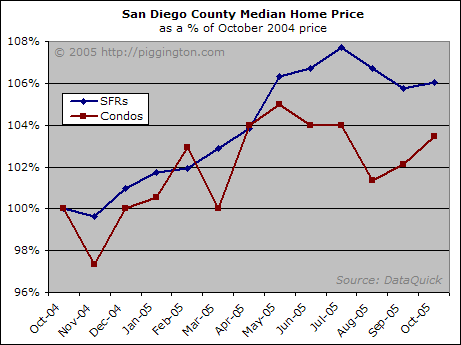
As you can see, the median condo price (while still off its spring high) has edged back up to recoup some of its losses, after turning in its first year-over-year negative appreciation number in September. (The reason that y-o-y appreciation is positive again is that last year’s October price was lower than last year’s September price, so October provided an easier year-over-year comparison).
The median home price also inched up a bit after three consecutive months of decline, but it remains below the price peak set in July.
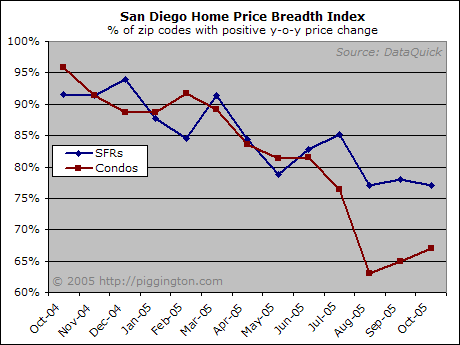
Market breadth was flatt-ish, as the number of zip codes with positive y-o-y appreciation remained close to unchanged. Zip codes with y-o-y declines of 5% or more also remained effectively unchanged overall, although as with breadth the condo market actually improved on the month while the SFR market deteriorated a bit.
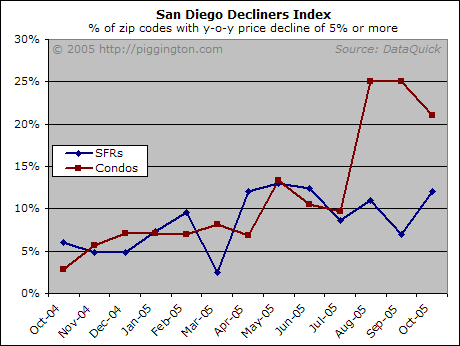
All in all there was nothing earthshattering to report in the price department. Prices usually meander around a bit in the winter. Given adverse credit market conditions they may start meandering more to the downside soon, but it hasn’t happened yet.
Sales
While price action was better for condos than SFRs, the opposite was true for sales volume. SFRs had a banner month, turning in 30% more sales than in October of 2004. Condos were quite a bit weaker comparitively, but even they made their first positive y-o-y sales volume comparison in a year:
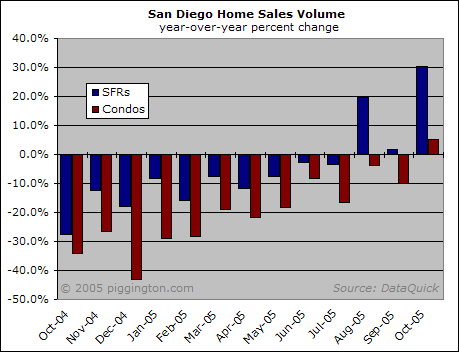

What caused this spike in volume? For one thing, this was a month for easy year-over-year comparisons in sales as well as price. October of 2004 was notably weak, with sales down over 30% from October 2003, so it wasn’t that hard to go up from there. I think the rest of the gain was caused by more fence-sitters being scared into buying by the deteriorating conditions in the mortgage market, as I discussed last month. It will be interesting in the coming months to see where volume goes in the face of the further rate increase that we’ve seen since October.
Inventory
Inventory has begun its expected seasonal slide, but it remains quite a bit higher than it was at this time last year:
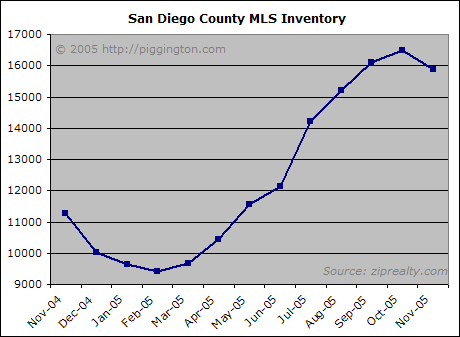
Countywide inventory is 41% higher than it was last November. Inventory in Downtown San Diego, meanwhile, is up 107% from this time last year:

Inventory always declines at this time of year as people take their houses off the market during the holidays. As the above graphs show, inventory should start rising again early in 2006 as people prepare for the expected spring rally.
There are now roughly 4 months of inventory on the market countywide (this includes only MLS listed properties, not new properties). This isn’t a terribly high number, but it’s not potential-rally material either.
Conclusion
While I believe the bubble is now deflating, it’s a verrrrry slow leak thus far. Volume is still decent, which means that there are plenty of people who still want to buy. Prices have declined off their spring/summer highs, but not by much. And while inventory has risen a lot, it’s not terribly high from a historical perspective. We are just cruising along, admittedly with a bit of a downward bias. Credit is the key here. If credit keeps tightening, the market will start to accelerate downward. This process will take months, as new rates and regulations affect new loans that affect new sales that finally show up in the statistics. But the process is taking place right now and, despite the decent month San Diego housing has just had, it could start to show up at any time.
